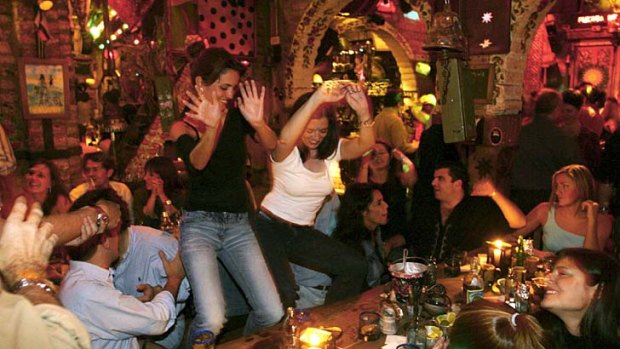
Patrons dance on their chairs at Andres Carne de Res, a popular restaurant in Chia, Bogata, Colombia.Credit: Getty Images
"You know, we could be in any place in the Viaduct right now," says Chris, who's from Auckland and apparently misses his home town's nightlife area. "Seriously, it looks just the same."
He's right, though. We're sitting at a wooden table outside a microbrewery, drinking jugs of boutiquey beer and watching the pedestrians stroll past. They're all very much like the place we're drinking in: stylish, upmarket types who wouldn't look out of place anywhere in the Western world.
There's a fancy restaurant across the street; the bar to the right is overflowing, people spill out to the pavement and let the sounds of salsa music wash over them; another bar nearby has been built in the shell of an old London double-decker bus. It's called, fittingly, Routemaster.
It could be the Viaduct, but it's not. It's not Australia, either, or anywhere in the West. We're in Bogota, Colombia.
Chris's fellow Kiwis back home probably wouldn't be too happy with the comparison. It's unlikely you will see the tourism slogan "Auckland: it's just like downtown Bogota" soon.
Because this is a city synonymous with all things scary. No one says, "This looks like downtown Bogota," and means it in a good way. I'm pretty sure that's what my parents used to say about my bedroom when I was a teenager.
It's dangerous here, or so the story goes. There's gun crime and drug crime and drug-related gun crime. Hotels get invaded and cars get hijacked. Lucky tourists get mugged and unlucky ones get shot. As a holiday destination, it sounds as attractive as Mogadishu.
But as we're finding out tonight, that's not exactly the case. It's rare you find a place that completely confounds your expectations, but Bogota is doing that - or at least it seems so from this perspective, behind a glass of beer at a microbrewery in an upmarket suburb.
To clear things up a little, I wasn't actually scared of going to Bogota. I had a feeling the stories were exaggerated, that Colombia had cleaned up its act since the days of Pablo Escobar and his cronies. I just wasn't expecting it to be nice.
You hear travellers rave about Cartagena, the Spanish colonial town that sits on Colombia's Caribbean coast. You hear people talk about the edgy energy of Medellin, or the spark of Cali. But no one talks up poor old Bogota.
I was picturing something like Guatemala City, a charmless place that acts solely as a gateway to its home country's more attractive destinations. There's an air of uneasiness in the GC (don't worry, that's not a nickname that's likely to catch on) and it would be no surprise to feel the same thing in Colombia's heaving capital.
But as we stroll the streets of the Parque de la 93 district, there's no tension, no nagging premonition we're about to get jumped.
In fact, if anything, I'm feeling a little silly - I've left all my bankcards at the hotel, taken only a small amount of cash, which is lodged in my front pocket, ditched my watch and worn only old clothes. But those precautions seem faintly ridiculous now.
This is, of course, the nicest part of Bogota. It's not as if bad things don't happen in this city - it's just that there are fewer bad things than you might expect.
Colombia's tourism slogan for the past few years has been: "The only risk is wanting to stay." It's cute but not entirely accurate. It should really be something like: "The only risk is getting stuck in traffic and not being able to leave."
That's because, of the potential dangers and annoyances in Bogota, it's the state of the traffic that gets to you. Traffic jams are the city's big frustration. You can spend hours trapped in the vast knots of cars and trucks and motorbikes and taxis that swell and surge and tangle in Bogota during the day. We were stuck in a humdinger a few hours ago, taking an hour and a half to drive the seven or so kilometres from the city centre to Parque de la 93. But we're here now, and life is good.
In fact, it's almost too good. Having spent so long mentally preparing for the rough edges of one of the world's scariest cities, it was something of a disappointment to see the Zara logo on the massive shopping mall, just next to the Ferragamo sign. And look over there - it's another Juan Valdez coffee shop, Colombia's answer to Starbucks. Of course, there's the inevitable McDonald's.
And this place is supposed to be dangerous? There's hardly an edge at all.
But that's not so bad because it's time for us to drain our beers and head out on those surprisingly placid streets. Maybe we'll go to one of the restaurants, or the salsa bar, or the double-decker bus place.
It's not the Viaduct. But it could be.
Have you ever been to a city with a bad reputation that defied your expectations? Post a comment below and share your stories.
Sign up for the Traveller newsletter
The latest travel news, tips and inspiration delivered to your inbox. Sign up now.